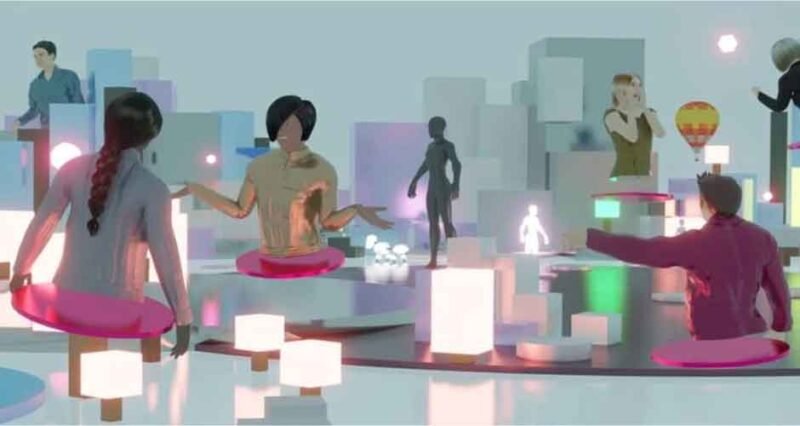
A staggering 40% of Spanish students are eager to embrace the metaverse in their educational journey, outpacing teachers’ interest, which lingers at 18%. This striking statistic from BBVA signals a generational shift towards immersive digital learning.
The metaverse, blending virtual and physical realities, is not just a tech trend but a potential revolution in education. It promises to reshape how we learn, offering unprecedented access and transforming teaching methods. As we examine the impact of metaverse development services on online education, we uncover the possibilities of a digitally enhanced learning future.
The Metaverse and Its Educational Potential
Can the metaverse redefine the boundaries of our classrooms? Could it be the key to unlocking a new dimension in learning and teaching? The metaverse now stands at the forefront of educational innovation, offering an immersive experience that transcends traditional learning environments.
The Essence of the Metaverse in Education
- Immersive Learning: In the metaverse, educational content is not just seen or heard; it’s experienced. This immersive approach can lead to a deeper understanding and retention of information.
- Global Classrooms: The metaverse erases geographical boundaries, enabling students from around the world to interact and learn together in a shared virtual space.
- Personalized Education: With AI-driven environments, the metaverse can offer personalized learning experiences, adapting to individual student’s needs and learning styles.
Potential Benefits
- Engagement and Motivation: The interactive and engaging nature of the metaverse can significantly boost student motivation and interest in learning.
- Practical Skill Development: Complex subjects can be taught through interactive simulations, providing hands-on experience in a risk-free environment.
- Accessibility: The metaverse can make high-quality education accessible to students regardless of their physical location, socio-economic background, or mobility limitations.
Practical Applications in Education and Training
The metaverse, with its immersive and interactive capabilities, offers a plethora of practical applications across various educational and training fields. Here’s a list of application cases in different domains, each backed by real-world examples:
Medical Training and Healthcare Education
- Application: Virtual reality simulations for surgical training, patient care scenarios, and anatomy education.
- Real-World Example: Stanford University’s Virtual Heart Program uses VR to train medical students and professionals in complex heart surgeries, allowing them to practice in a risk-free, realistic environment.
Engineering and Architectural Design
- Application: 3D modeling and simulation of engineering projects, virtual walkthroughs of architectural designs.
- Real-World Example: The University of Illinois integrates VR into its architectural studies, enabling students to virtually tour and interact with their 3D building models.
Environmental Science and Geography
- Application: Virtual field trips to remote or inaccessible locations, interactive models of ecological systems.
- Real-World Example: Google Earth VR allows students to explore different geographical landscapes and ecosystems globally, enhancing their understanding of environmental science.
Corporate Training and Professional Development
- Application: Virtual workshops and team-building exercises, soft skills training through interactive scenarios.
- Real-World Example: Accenture has developed a VR-based training program for its employees, focusing on leadership and collaboration skills in a virtual office setting.
Language Learning and Cultural Immersion
- Application: Language practice in native-speaking environments, cultural immersion experiences.
- Real-World Example: ImmerseMe is an application where learners can practice languages in VR settings, engaging in conversations with virtual characters in different scenarios.
History and Archaeology
- Application: Virtual reconstructions of historical sites and events, interactive archaeological explorations.
- Real-World Example: Anne Frank House VR allows users to virtually explore the secret annex where Anne Frank and her family hid during World War II.
Art and Design Education
- Application: Virtual art studios and galleries, 3D design, and sculpture.
- Real-World Example: The Savannah College of Art and Design (SCAD) has created a VR catalog so that prospective students can gain firsthand experience of studying at SCAD before they enter the institution.
Special Education and Inclusive Learning
- Application: Customizable learning environments for students with special needs, sensory-friendly educational content.
- Real-World Example: The Floreo VR system is used for teaching social and communication skills to neurodiverse learners, offering a controlled and engaging learning environment.
In Conclusion
As we stand at the cusp of a new era in education, the metaverse emerges not just as a technological novelty, but as a transformative force poised to redefine the educational landscape. The journey through various applications in fields ranging from medical training to historical exploration has illuminated the vast potential of metaverse development services in enriching and diversifying learning experiences.
Looking ahead, the future of metaverse education is bright with promise. We can anticipate further advancements in virtual reality technology, making these experiences more immersive, accessible, and tailored to individual learning needs. The integration of AI and machine learning will likely enhance the personalization of educational content, catering to diverse learning styles and abilities.

